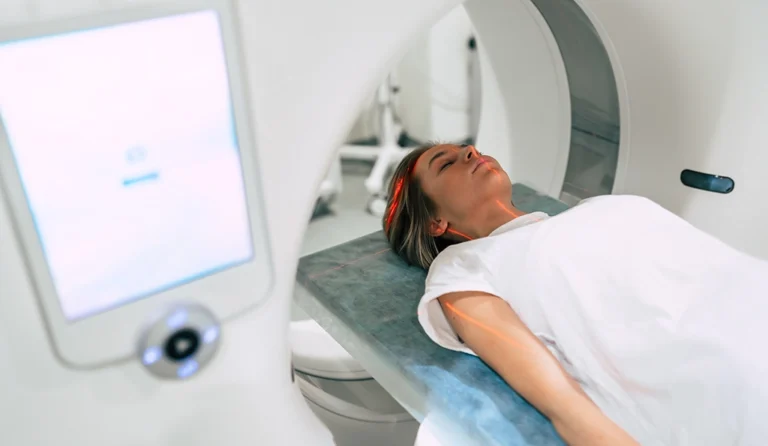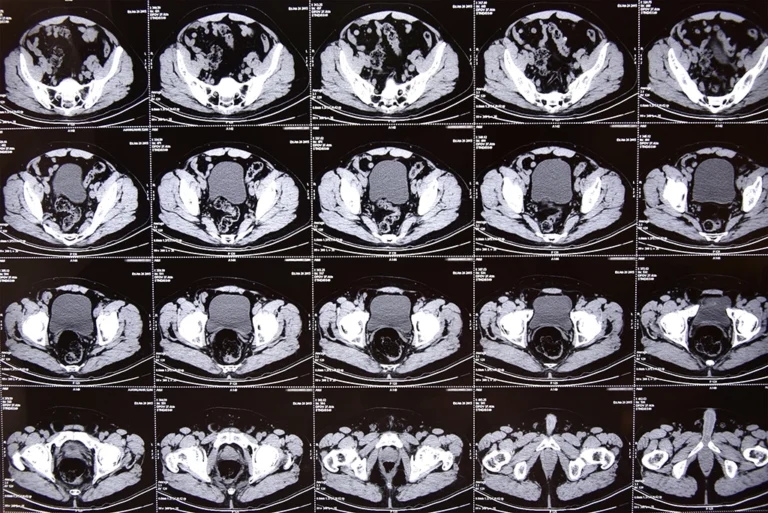When your healthcare provider recommended a pelvic CT scan to learn more about the stage of your testicular cancer, you may have been a little worried. That’s completely understandable. Keep in mind that the more your provider knows about your health, the better prepared you’ll be, moving ahead.
We’re here to help you learn more about getting a pelvic CT scan. Finding out whether the cancer has spread to other parts of the body is important to help shape treatment and to understand the extent of the disease.
A pelvic CT scan can help your team of doctors understand exactly where the cancer is located, and can provide the information you and your healthcare provider need to move forward with a plan of care. Let’s learn how a pelvic CT scan can help to stage testicular cancer.
How pelvic CT results can help your provider to determine the stage of testicular cancer
A pelvic CT scan will be able to show whether your testicular cancer has spread to lymph nodes or other areas of the body. Knowing the stage of cancer means understanding whether the cancer has spread beyond the testicles, and if so, to what extent.
How do radiologists examine pelvic CT images to assess how far the cancer has spread?
When radiologists look at pelvic CT images they have guidelines that help them know how far the cancer has spread. If a lymph node looks swollen or enlarged it may be because the cancer has spread to the lymph node.
A radiologist will be able to see the size, shape, and appearance of lymph nodes on the scan to help determine this. Likewise, any abnormal masses or growths in the pelvic area could mean cancer has spread beyond the lymph nodes and into areas such as the bladder, prostate, and rectum.
What is the TNM system? How can it help to stage testicular cancer?
The TNM system is a way your care team describes how far cancer may have spread in the body. It helps your provider understand the full picture of your condition and plan the most effective treatment.
The TNM system looks at three things:
- the size and spread of the main tumor (T),
- whether cancer has reached nearby lymph nodes (N),
- whether it has spread to other parts of the body like the lungs or liver (M).
For testicular cancer, the TNM system is especially important because the stage of the cancer can shape your treatment plan. A pelvic CT scan can help by showing whether the cancer has spread to your lymph nodes or other nearby areas of your body.
Along with other tests that check for tumor markers, like a blood test, a CT scan gives your provider the information they need to figure out the stage of testicular cancer.
How are scan results used to classify testicular cancer into Stage I, II, or III?
The results from your pelvic CT scan will be used to help discover whether the cancer has spread, and if so, how far the cancer has spread. The guidelines for Stage I cancer mean that the cancer has not spread beyond the testicles.
Stage II means that testicular cancer has also been found in one or more of the lymph nodes in your abdomen. Stage III means that the testicular cancer has spread beyond the lymph nodes into other organs or areas of the body.
How does the involvement of lymph nodes or distant tissues affect the assigned stage?
The three stages reflect the spread of testicular cancer. Lymph node involvement means the cancer is Stage II. Depending on what the lymph nodes show, this could be early Stage II or higher Stage II.
Early Stage II means fewer lymph nodes are involved, or that the ones that are involved are not as enlarged as they would be in the Higher Stage II. Stage III means that signs of cancer are seen in other organs or tissues beyond the lymph nodes.
View our available pelvic CT appointments at a location near you today
How the cancer stage helps your provider understand your condition
Your healthcare provider can use the scan results to help give a clearer picture of your condition. Knowing whether the cancer is Stage I, II, or III means that the cancer is either contained in one area or has spread into other parts of the body.
How does the stage help your provider understand how aggressive the cancer may be?
The stage of your testicular cancer, which is how far the cancer has spread, suggests how aggressive your cancer could be. If the cancer has spread beyond the testicles, it is more aggressive than if it has stayed in one spot.
An aggressive cancer will travel throughout the body, typically starting with lymph nodes and then to other areas of the body. Along with blood test results, the stage is a key indicator of what kinds of treatments will be the best choice in treating your cancer.
How does your staging information guide expectations for recovery or disease progression?
The staging information helps your healthcare provider understand more about how to approach treatment for your testicular cancer. Treatment for and recovery from testicular cancer in Stage I are different from cancer in its more advanced stages.
Whether surgery, radiation, or chemotherapy is most appropriate will depend on the spread and type of cancer that is found. While Stage I cancers have a more successful cure rate, even Stage III testicular cancer is considered curable in most cases.
How can the stage shown on your scan affect the urgency or intensity of treatment?
The stage shown on your CT scan helps determine the course of treatment your healthcare provider will recommend. A Stage I cancer is contained in one area, which could be treated more locally than a Stage III cancer, which has already spread to other areas of your body.
Whether to choose surgery, radiation, chemotherapy, or other treatments is greatly influenced by the stage found on your scan. A more advanced stage suggests the need for a more urgent and intense plan to treat the cancer.
How a pelvic CT scan checks if testicular cancer has spread
A pelvic CT scan uses x-ray technology to take multiple images of the pelvic region, creating 3-D images from all different angles, so that any abnormal growth or abnormal tissue will appear as a distinct image on the scan. Areas seen on the scan typically include lymph nodes, bladder, and prostate, as well as other areas of the abdomen that could be affected.
How does the scan show whether cancer has reached lymph nodes in the pelvis or abdomen?
The scan includes images of the lymph nodes in the pelvis and abdomen. If a lymph node looks enlarged on the scan, it may be because it contains cancer cells.
Cancer often travels through lymph nodes in the body, so they are studied early on to help determine the stage of the cancer. If a lymph node looks enlarged or suspicious, a biopsy of the node can be done to look for the presence of cancer cells.
How can a pelvic CT scan detect signs of tumors in nearby soft tissues or organs?
A pelvic CT scan provides detailed images of the soft tissues and organs in the pelvic area. The size, shape, location, and extent of any abnormal growth or tumor within soft tissues or organs will be clearly seen on the scan.
Tumors will look different from healthy tissue on the scan, and an organ may look unusual in its shape or size, which could suggest a tumor is present.
How do the number and size of abnormal areas help reveal how far the cancer has traveled?
There are specific guidelines when it comes to reading the scans that help radiologists to determine how far the cancer has traveled. These guidelines include things like the tumor’s size, any lymph node involvement, and the presence of cancer cells in other parts of the body.
That’s where the TNM system, which helps your provider to determine the stage of testicular cancer, helps your provider to create a treatment plan for your care. Taken together, these factors help providers determine how far the cancer has traveled throughout the body.

How CT results can support your planning for treatment and follow-up care
Pelvic CT scans important information to help confirm a cancer diagnosis and plan appropriately for treatment. The scans will show exactly where the cancer is located, and whether it is contained, or if it has spread to other organs or areas of the body.
How do CT scan findings help your provider choose your follow-up options?
A pelvic CT scan will help your healthcare provider know whether your condition is one that can best be treated by surgery, radiation, chemotherapy, or a combination of these approaches.
Once your treatment is complete, they may follow-up with continued scans to make sure the cancer does not return. Monitoring your condition post-treatment is essential to continued care, and the findings of pelvic CT scans will play a significant role in knowing whether your cancer treatment has been successful.
How can a pelvic CT scan help identify lymph nodes that may need medical attention?
Because lymph nodes are a common route for cancer to spread, a pelvic CT scan that provides detailed, cross-sectional images of the lymph nodes is essential to monitoring the treatment of your cancer.
If a lymph node appears abnormal in size or shape on the scan, it may need to be biopsied so that a better understanding of its health can be found. The images found in your pelvic CT scan will show whether the lymph nodes are in good health or in need of further study.
How can your CT results help to determine how well a treatment is working?
Your pelvic CT scan results will show how well your treatment is working by monitoring tumor size or shape, during your treatment, as well as during your follow-up care. Repeated CT scans taken over time can show whether treatment has been successful in stopping the spread of cancer.
Your results can also show whether cancer has spread to other parts of the body, or if it has been contained to one area. Monitoring to check for any future recurrence can help make sure any cancer that returns is caught early so that it can be treated appropriately.
How to schedule an appointment with us
Our goal is to offer you and your healthcare provider the most informative results possible, and we make it easy for you to get an appointment.
With numerous locations across South Jersey, you’ll find us conveniently located near major highways and key bridges in the region.
We’ll ensure the entire scheduling process is as effortless as possible for you. Above all, we are here to help you.
Reach out to us at any of the following locations to book an appointment:
- Haddonfield Office – Haddonfield, NJ
- Marlton (Greentree) Office – Marlton, NJ
- Medford Office – Medford, NJ
- Moorestown Office – Moorestown, NJ
- Mount Laurel Office – Mount Laurel, NJ
- Route 73 (Voorhees) Office – Voorhees Township, NJ
- Sewell (Washington Township) Office – Sewell, NJ
- Turnersville Office – Turnersville, NJ
- Voorhees (Carnie Boulevard) Office – Voorhees Township, NJ
- West Deptford Office – West Deptford, NJ
- Willingboro Office – Willingboro, NJ
Learn more about the board-certified, subspecialized radiologists who read, analyze and interpret the findings here at South Jersey Radiology Associates.
Frequently Asked Questions
A pelvic CT scan helps your provider check if the cancer has spread beyond the testicle, which is key to figuring out the stage.
They examine the scan for enlarged lymph nodes or abnormal growths in the pelvis and abdomen that may signal cancer spread.
The results show whether cancer has remained localized or spread to lymph nodes or distant tissues, which defines the stage.
If cancer is found in lymph nodes or beyond, it usually means a higher stage and may call for more aggressive treatment.
The stage gives a clearer picture of how advanced the cancer is and helps estimate how quickly it might grow or return.
Yes, more advanced stages seen on the scan may prompt quicker or more intensive treatment decisions.
Comparing scans over time shows whether tumors or affected lymph nodes are shrinking, growing, or staying the same.
It helps your provider decide how often you need checkups and whether certain lymph nodes should be monitored or treated.



